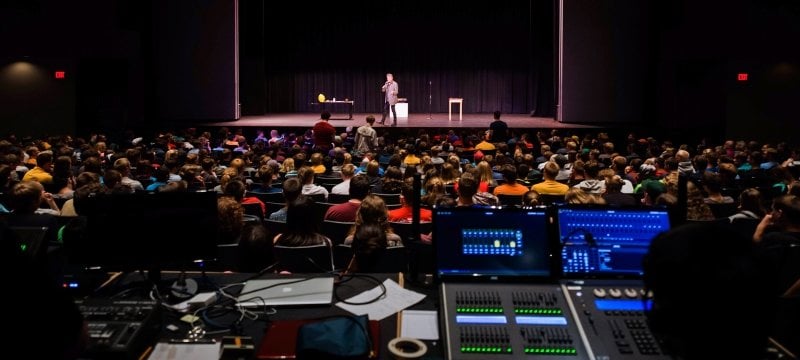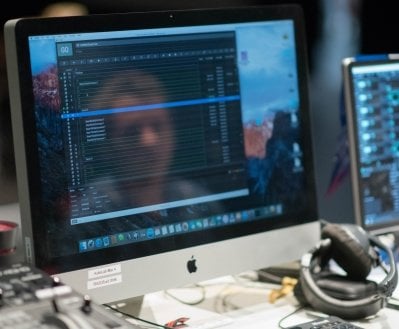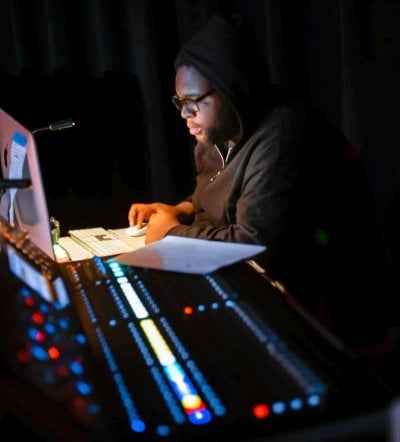At Michigan Tech, students take one of the oldest art forms known to man and give it some high-tech juice.
Modern theatre dates back to sixth century BC Greece when the poet Thespis won an oratory contest and became the first . . . thespian. Yet the art of performing likely began in Indigenous cultures with the oral tradition of storytelling.
Of course, no matter the century, those early performances look nothing like today's. Take a stroll backstage at any Michigan Tech production and you'll see that computers are as common as spotlights. But ancient theatre does share a common bond with theatre today—a reliance on science.
Josh Loar, professor of practice in Tech's Department of Visual and Performing Arts (VPA), says the science of sound is complex. "There is so much science involved in sound design—acoustics, electronics, physics, data networking, computer programming, and on and on."
Loar says the marriage of art and science is not a modern phenomenon. "Storytelling in a cave relied on an understanding of acoustics. Storytellers would make sure their backs were to the wall to enhance their sound. The Greeks built their theatres on hillsides, taking advantage of natural acoustics. Science has always been a part of theatre."
A Technological Art and Craft
At Michigan Tech, the science of sound, and in particular sound design, is serious business. World-renowned sound design and audio production and technology programs boast a 100 percent job placement rate. "Our graduates get hired, period," Loar says. Many of those graduates walk right into high-level jobs throughout the entertainment industry. And each of those jobs, whether it's running a mixing console at an arena rock concert, designing sound for a video game, or working with a regional opera company, demand knowledge of and training in many scientific disciplines.
"Sound design and production in all its forms is a technological art and craft," Loar says. "While the discipline of acoustics is the foundation of how we experience sound, we can't understand how to produce it if we don't understand the fundamentals of electrical theory, of digital audio theory, of transducer design, computer and networking practice, and so on. The better they understand all the technological underpinnings, the more able students are to truly create and innovate in sound."
"What a handgun sounds like in real life is not what we want Indiana Jones' handgun to sound like—his must be bigger and more powerful because he's the hero."
Perhaps the biggest difference between ancient theatre and today's entertainment industry came about in 1975 when A Chorus Line incorporated computers into live theatre for the first time. Today, students often run all the sound cues for a rehearsal or performance from a tablet that allows them to hear the show from various parts of the house without being tethered to a control setup.
"An understanding of computer science is a prerequisite for sound design. Virtually everything we do involves computers. Sound recording, audio processing, editing, and even pre-show sound checks and the running of the show itself are all done with computers," Loar says.
Begin With Nature
An understanding of the technical aspects of sound design isn't enough when you're dealing with art, especially an artform as intimate and personal as theatre. Loar says the study of sound design starts with listening in great detail to the world around us: "We must first pay very close attention to the sounds that surround us, both human-made and natural. From there, we must begin to ground ourselves in the storytelling traditions of theatre, film, television, and video games."
He says where reality and fantasy mesh is where the real beauty of sound design can be found, and of course science plays a huge role. In the movie Raiders of the Lost Ark, for instance, Loar says the sound of Jones' handgun was a blend of sounds made in real life by much heavier weaponry.
According to Loar, to make the appropriate connection with an audience, it is essential to understand how they feel and how you want them to feel. That's where an understanding of the science of human factors and psychology come into play. "If we observe how sound is used, how it makes us (and others) feel, we start to use our creative tools to shape an audience's perception and emotional experience."
If you don't know that a creaking hinge makes people feel creeped out in a horror movie, then you can't manipulate that perception. "But if we do know that, then we can put a creaking hinge where we wouldn't expect it and subvert the expectation, change the mood of a moment. On the flip side, if a gate-opening scene in a creepy cemetery makes the sound of a squeaking rubber ducky, we can elicit a laugh from the absurdity of the unexpected."
Knowing when to give an audience what they expect or want, versus when to cut against that, is a huge part of the art form. This, of course, is another area where art and science come together.
Hiding in the Mine
Senior sound design student Aaron Christianson, one of the lead sound designers for VPA's Haunted Mine project at the Quincy Mine, uses a knowledge of psychology when determining speaker placement.
"As sound designers, we know that audio is perhaps the most triggering human sense," Christianson says. "We are very aware of that when we design a show or system. The goal is to make sounds come from a place that makes sense, so it seems more believable to the audience. We also don't want them to really know that it is coming from this speaker in this place, so we do our best to hide them in a way that gives us the highest possible sound quality to facilitate our intent."
Christianson says several scientific aspects come into play for the Haunted Mine; however, when the goal is to scare people, psychology comes to the forefront, as the sound designers need to understand what sounds truly scare people.
"Most children have a shared traumatic experience that is pretty common—creepy clowns, large-scary-monster noises, spiders, snakes, to name a few. We know a bank of real-world, easily obtainable sounds that can be sourced and edited slightly to make them even more creepy. One of the best parts is having a sound come from something you can't see, and a sound that is altered enough so you can't really tell what it is."
While theatre is an expressive, intimate, and personal art form, sound design and audio production and technology students at Michigan Tech know that science is the driving force behind the art.
On the Mic
by Mark Wilcox
I've been in dozens of plays since the early 1970s. However, it wasn't until a 2013 Michigan Tech production of Fiddler on the Roof that I wore a microphone on stage. I certainly understood why; singing over a full orchestra to a packed 1,000+ seat house, I needed all the help I could get.
A year later I was in a production of Antigone in the McArdle Theatre, a "black box" theatre in the Walker Arts and Humanities Center. It was a small and intimate setting where the actors were within feet of the audience. As a matter of fact, my character sat in the audience and rose several times to comment on the action of the play.
Once again, I was mic'd up. And to be honest, I was offended. While my college drama-major days were a few decades behind me, I was trained to "hit the back wall" from the stage of pretty much any auditorium.
It was at that point when I really understood what sound design at Michigan Tech was all about. In my limited experience with sound design for live theatre, I assumed microphones were only used for amplification.
What I didn't know was that sound design students do much more to the human voice than make it louder.
"We'll use voice processing software to create special effects," Josh Loar says. "It's not about making it louder, but shaping the sound." For Antigone, the voice processing melded with the other digital sound effects to create a mystical ambiance in the telling of the Greek tragedy.
In a production of Steve Martin's Picasso at the Lapin Agile, the digital voice processing blended in with a myriad of other sound effects.
For a 2018 production of Shakespeare's A Midsummer Night's Dream, voice processing was used on actresses' voices so the fairies sounded just like fairies—or at least what I would expect fairies to sound like.
Couple voice effects with strategic speaker placement, and audiences are treated to an "out-of-this-world experience," even when the actors are 10 feet away.
It takes more than magic to bring Shakespeare’s “Midsummer Night’s Dream” to life. Let’s go backstage before the Michigan Tech Theatre Company’s opening night.
Michigan Technological University is an R1 public research university founded in 1885 in Houghton, and is home to nearly 7,500 students from more than 60 countries around the world. Consistently ranked among the best universities in the country for return on investment, Michigan's flagship technological university offers more than 120 undergraduate and graduate degree programs in science and technology, engineering, computing, forestry, business, health professions, humanities, mathematics, social sciences, and the arts. The rural campus is situated just miles from Lake Superior in Michigan's Upper Peninsula, offering year-round opportunities for outdoor adventure.







